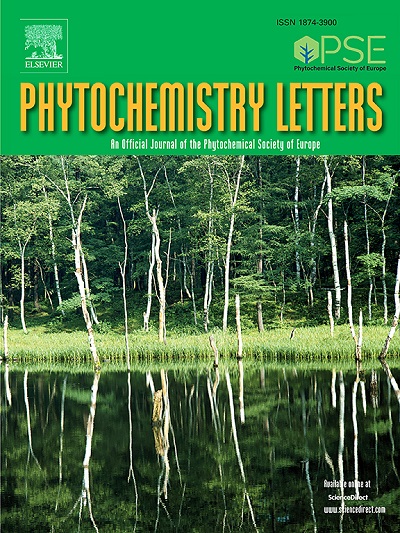Antifungal naphthalenes and related polyketides from the cranberry (Vaccinium macrocarpon) endophyte Protoventuria sp.
IF 1.4
4区 生物学
Q4 CHEMISTRY, MEDICINAL
引用次数: 0
Abstract
Ericaceous plants, including high-value fruit crops, harbor phylogenetically diverse fungal endophytes. A collection of ∼350 fungal endophytes from Canadian fruit-bearing plants was generated to investigate the taxonomic and secondary metabolite diversity of these poorly studied fungi. A putatively novel species of Protoventuria was isolated as an endophyte from a cranberry (Vaccinium macrocarpon) leaf in Central Ontario promoting an investigation of its secondary metabolites. From this fungus, two new naphthalenes, protoventurenes A and B (1–2), were characterized by LC-HRMS and NMR spectroscopy. Two additional structurally similar metabolites were also identified, the naphtalenone fragranone (3), previously reported from a shrub in Thailand, and the phenalenone derivative lamellicolic anhydride (4) originally from Verticillium lamellicola. Metabolites 1–4 inhibited the growth of the plant pathogen Botrytis cinerea with a 100-µg dose, and protoventurene B (2) inhibited Colletotrichum gloeosporioides at the same concentration. The investigation of ericaceous endophytes continues to reveal ecologically unique fungi and their new secondary metabolites.
蔓越莓(Vaccinium macrocarpon)内生菌原venturia sp.的抗真菌萘和相关聚酮。
埃里科植物,包括高价值的水果作物,拥有系统发育多样的真菌内生菌。为了研究这些研究较少的真菌的分类和次生代谢物多样性,研究人员收集了来自加拿大结果植物的约350种真菌内生菌。在安大略省中部的蔓越莓(Vaccinium macrocarpon)叶片中分离到一种推测为新种的原生venturia内生菌,促进了对其次生代谢产物的研究。用LC-HRMS和NMR对该真菌中2个新萘化合物原venturerenes A和B(1-2)进行了表征。另外两种结构相似的代谢物也被鉴定出来,一种是先前报道的来自泰国灌木的萘talenone fragranone(3),另一种是phenalenone衍生物lamellicolic anhydride(4),最初来自Verticillium lamellicola。代谢物1-4以100µg剂量抑制植物病原菌灰霉病菌(Botrytis cinerea)的生长,原venturerene B(2)在相同浓度下抑制gloeosporioides。对芥菜内生菌的研究继续揭示生态上独特的真菌及其新的次生代谢产物。
本文章由计算机程序翻译,如有差异,请以英文原文为准。
求助全文
约1分钟内获得全文
求助全文
来源期刊

Phytochemistry Letters
生物-生化与分子生物学
CiteScore
3.00
自引率
11.80%
发文量
190
审稿时长
34 days
期刊介绍:
Phytochemistry Letters invites rapid communications on all aspects of natural product research including:
• Structural elucidation of natural products
• Analytical evaluation of herbal medicines
• Clinical efficacy, safety and pharmacovigilance of herbal medicines
• Natural product biosynthesis
• Natural product synthesis and chemical modification
• Natural product metabolism
• Chemical ecology
• Biotechnology
• Bioassay-guided isolation
• Pharmacognosy
• Pharmacology of natural products
• Metabolomics
• Ethnobotany and traditional usage
• Genetics of natural products
Manuscripts that detail the isolation of just one new compound are not substantial enough to be sent out of review and are out of scope. Furthermore, where pharmacology has been performed on one new compound to increase the amount of novel data, the pharmacology must be substantial and/or related to the medicinal use of the producing organism.
 求助内容:
求助内容: 应助结果提醒方式:
应助结果提醒方式:


